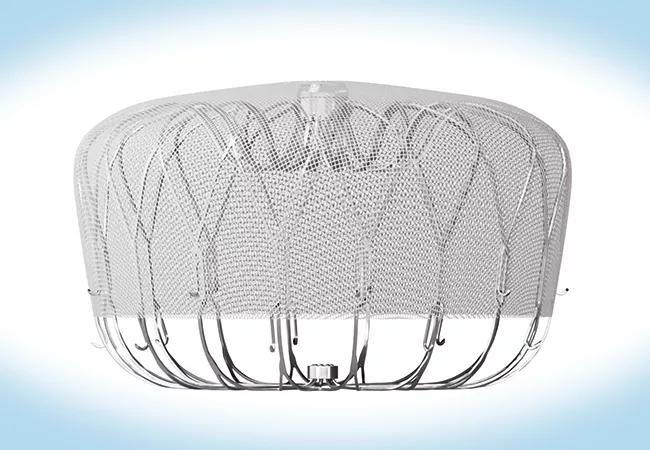Large SURPASS registry study finds LAAO device safe and effective through one year

Routine clinical use of the WATCHMAN FLX left atrial appendage occlusion (LAAO) device for stroke prevention in patients with high-risk nonvalvular atrial fibrillation achieves similar safety and efficacy outcomes through one year as those achieved in the PINNACLE FLX clinical trial, which led to the device’s FDA approval in July 2020.
Advertisement
Cleveland Clinic is a non-profit academic medical center. Advertising on our site helps support our mission. We do not endorse non-Cleveland Clinic products or services. Policy
So found the real-world SURPASS study, involving more than 95,000 patients from the American College of Cardiology’s National Cardiovascular Disease Registry (NCDR) LAAO Registry™. The study was published online in Circulation: Cardiovascular Interventions (Epub 2024 Jul 26).
“We were most interested in knowing that the WATCHMAN FLX, which is now widely implanted by thousands of different operators, is safe,” says the study’s lead investigator and corresponding author Samir Kapadia, MD, Chair of Cardiovascular Medicine at Cleveland Clinic. “The SURPASS study, with its very large dataset from across the U.S., confirmed that the favorable outcomes we saw in a clinical trial setting are being replicated in the community.”
The WATCHMAN FLX is a second-generation LAAO device that underwent several design changes from the initial WATCHMAN 2.5, which had well-established safety and efficacy. Alterations were designed to address complications, especially peridevice leak and device-related thrombosis, and to ease implantation and treat a wider range of LAA anatomy.
The WATCHMAN FLX demonstrated favorable safety and efficacy in PINNACLE FLX, the 12-month investigational device exemption study involving 400 patients, as well as in smaller studies in Europe and the U.S.
Over the past 10 years, implantation of an LAAO device has become an established stroke prevention option for patients with atrial fibrillation who are poor candidates for oral anticoagulation therapy, and thousands of the devices are implanted monthly in the U.S.
Advertisement
SURPASS was designed to evaluate safety and efficacy outcomes of the WATCHMAN FLX device in routine clinical practice.
The SURPASS cohort consisted of 97,185 patients from the NCDR LAAO Registry who underwent WATCHMAN FLX implantation at 772 U.S. hospitals between August 2020 and September 2022.
Compared with PINNACLE FLX, patients at baseline in the SURPASS study:
The procedural implant success rate in SURPASS was 97.5%.
Key comparisons between the SURPASS cohort (N = 97,185) and the PINNACLE FLX cohort (N = 400), were as follows:
Advertisement
“The key safety outcome of major adverse events before hospital discharge occurred at a similar rate of approximately 0.5% in SURPASS and PINNACLE FLX despite the higher risk profile of SURPASS patients,” Dr. Kapadia notes. “This and the other safety outcomes provide good reassurance that the device is being used safely.”
The study authors point out that patient management differed between SURPASS and PINNACLE FLX, likely contributing to the safety results observed in the SURPASS cohort. At discharge, PINNACLE FLX patients were prescribed a direct oral anticoagulant plus aspirin, per study protocol, whereas only about 40% of SURPASS patients received this regimen. Many SURPASS patients were provided an oral anticoagulant alone, and evidence since the PINNACLE FLX trial suggests that this may lead to a lower risk of adverse events through 45 days.
Dr. Kapadia notes that SURPASS, being a registry study, was not specifically designed to evaluate efficacy, as full outcomes data were not available. “Our primary objective was to assess safety in real-world settings, in view of the widespread adoption of the WATCHMAN FLX,” he says. He adds, however, that given the study’s huge dataset, evidence is strong that efficacy outcomes were comparable to those in PINNACLE FLX. “Ongoing randomized controlled trials such as OPTION and CHAMPION-AF will provide further clarity on efficacy,” he notes.
“These data from SURPASS leave little doubt that LAA occlusion is a safe and effective strategy for stroke prevention in patients with nonvalvular atrial fibrillation,” says Mohamed Kanj, MD, Associate Director of Electrophysiology Laboratories in Cleveland Clinic’s Department of Cardiovascular Medicine. “The rate of reported stroke was a quarter of what you would expect in this population. The WATCHMAN FLX device gets much of the credit because it has improved the procedural success rate and reduced the rate of adverse outcomes.”
Advertisement
“The results of this latest SURPASS analysis are very encouraging, especially the high implant success rate,” adds Oussama Wazni, MD, MBA, Section Head of Cardiac Electrophysiology at Cleveland Clinic. “This is made possible by the device’s wider range of sizes and the operator’s ability to adjust its placement to obtain the best possible closure.”
The SURPASS analysis was supported by Boston Scientific Corporation, which markets the WATCHMAN FLX.
Image of the WATCHMAN FLX device is courtesy of Boston Scientific.
Advertisement
Advertisement

New analyses confirm preservation of ablation outcomes, broaden data on bleeding benefits

OPTION trial demonstrates significantly less bleeding risk with comparable efficacy

Application to flutter found safe and effective in study of 300+ patients

LAA closure may be compelling option in atrial fibrillation ablation patients at high risk of both stroke and bleeding

UK experts compare and contrast the latest recommendations

Check out our latest data in these core cardiovascular areas

While results were negative for metformin, lifestyle counseling showed surprising promise

Recent volume and outcomes data in two major realms of cardiovascular care